
How can one of the world’s largest exporters of gas and coal have such high electricity prices at home?
That’s the question energy expert James Sturch tackles in this deep and sometimes confronting conversation. From flawed federal policy and corporate lobbying to outdated infrastructure and global geopolitics, the discussion reveals just how broken Australia’s energy system is—and what can be done to fix it.
Hurricanes, Climate, and the CO₂ Cost We Ignore
In the wake of catastrophic U.S. hurricanes, some of the worst on record, James doesn’t mince words. “They’re faster, stronger, more frequent—and they’re happening because of decades of CO₂ emissions.” He calls for immediate action: end coal expansion, scale back gas extraction, and fast-track renewables.
Gas Exports vs Local Prices – A National Scandal
Australia, the world’s second-largest gas exporter, sells gas overseas cheaper than locals pay at home. Why? Long-term contracts and poor energy policy.
“We basically give it away and then buy it back at inflated prices,” James says.
Even worse, domestic consumers fund the infrastructure through their bills—while profits go offshore, and companies avoid local taxes.
Renewables Are Cheaper—But Still Starved of Support
Despite solar and wind being the cheapest forms of energy generation, fossil fuels receive the lion’s share of subsidies.
“It’s disgusting,” James says bluntly. “The support renewables get is a fraction of what fossil fuels receive.”
He also points out that the true cost of fossil fuels—pollution cleanup, health impacts, and climate disasters—isn’t factored into pricing.
Electricity Bills Aren’t About Energy—They’re About Fees
Most Australians don’t realise the energy component of their bill isn’t the problem—it’s everything else.
Transmission fees (even if your solar powers your neighbour).
Daily “connection fees” as high as $140 in some areas.
Metering charges—even with digital meters.
Retailer markups.
This structure, built on outdated assumptions from the last century, keeps prices artificially high.
Smart Meters, Dumb Outcomes
Mandatory smart meters promise more control and insight—but often deliver the opposite.
Consumers must pay for installation.
They can’t access their own real-time data.
Pricing gets more complex (not clearer).
The result? More control for retailers, less transparency for you.
Community Batteries – Greenwashing or Grid Stability?
Community batteries are marketed as a way to stabilise local grids and help residents share energy. But in reality, they’re owned by networks, not communities.
“The community pays part of the cost, but doesn’t own the asset,” James says. “It adds value to the energy company—not the homeowner.”
In most cases, the only benefit to consumers is the ability to export slightly more solar—at minimal financial value.
The Manufacturing Exodus and Australia’s Missed Opportunity
High energy costs have forced iconic manufacturers to close. But James sees opportunity in the renewable supply chain.
“We should be building our own panels, inverters, racking—everything,” he says.
With enough support, Australia could become a renewable manufacturing powerhouse, reducing imports and creating jobs.
Cybersecurity, EVs, and Data Privacy Risks
From EVs to solar inverters, the rise of connected tech brings new threats. Data often flows to foreign servers, including in China. Without clear standards and legislation, Australians remain vulnerable to privacy breaches and misuse.
Market Reform Is the Only Path Forward
James proposes bold reform:
Restructure distribution fees based on actual power flow.
Incentivise residential batteries and solar diverters.
Reward consumers for storing power during the day.
Use existing battery infrastructure (like in Germany) to avoid massive new transmission builds.
Allow communities to become microgrids and trade locally.
Why Trust Is Broken (And How to Fix It)
The public no longer trusts energy companies—and with good reason.
Opaque tariffs. Constant policy changes. Incentive programs that benefit corporations more than consumers.
VPPs (Virtual Power Plants) are a prime example—offering potential savings, but few guarantees.
“Would you let someone else drive your new car like an Uber? It’s the same question with batteries,” James warns.
Conclusion: A Nation at a Crossroads
James believes Australia has the resources, technology, and talent to become a renewable superpower. But it needs political will, transparent policy, and structural reform.




